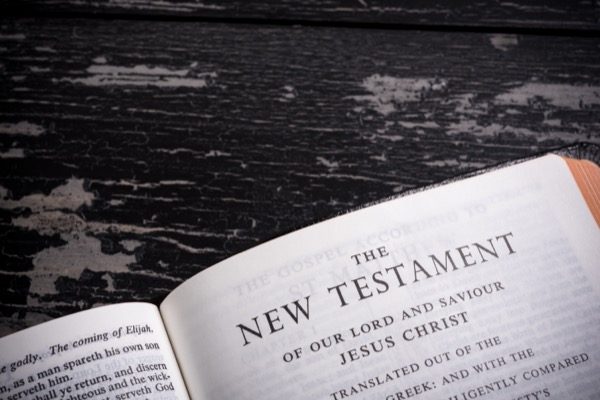From The Review of Religions, November 1931, No.11, Vol.XXX
More than nineteen hundred years ago two children were born, one in the wild region which borders the head of the Dead Sea, and the other near Bethlehem. These two children were later on called as John(as) and Jesus(as). The former was six months older than the latter, and their births are regarded as miraculous because the parents of John(as) were very old and Jesus(as) had no physical father. When John(as) was in the womb he was filled with what is called the Holy Ghost, and Mary, the mother of Jesus(as), conceived by the “Word” (sign) of God first and the child born of this conception appeared later on as a “man-God.”
For a Muslim John(as) and Jesus(as) are true prophets of God like other prophets, and all were His creatures brought into existence by His creative power. It is through these prophets God spoke and revealed deep secrets of nature and of divine wisdom in order to enlighten and reform mankind and to give glad tidings and warnings.
About John(as) we do not know much until he appeared on the banks of the River Jordan. Before that, it is said, he was wandering in the wilderness, eating locusts and wild honey, covering his body with a cloth made of camel’s hair, tied with a leather girdle (Mark 1:6). He is believed to have belonged to a Jewish religious sect called “Essenes” from whom sprang up the early Christian Ebionites or Nazarenes whose principal characteristic was to abstain from worldly pleasure.
When he appeared at the River Jordan, John(as) began his mission of preaching repentance and baptised the penitent sinners with water. Many penitent Jews were baptised by him in the water of the river Jordan, and among others, one was Jesus(as). During John(as)’s baptismal performance he said that there was coming after him another Prophet who would baptise with the Holy Spirit (Mark 1:8).
Before I touch on the prediction of John the Baptist(as) with regard to the Prophet who was to come after him, let me point out the effect of the baptism received by Jesus(as) at the hands of John(as). As soon as Jesus(as) received the baptism the Holy Ghost descended in the form of a “dove.” Why was it called a dove? Is the language here symbolical? Or was it really a bird, a “dove,” that descended upon him?
F. C. Conybeare (1856-1924) answers this question thus:
“In Syria and Palestine in that age the “dove” was a sacred bird, never molested or killed, being protected by ancient and wide-spread religious taboos. Philo, in his dreamy allegorical way, seeks to account for the bird’s sacro-sanctity. As the best of animals, he says, the lamb is a symbol of the purification of what is best in us – namely, our mind and intelligence, so also birds, light and winged, which move more swiftly than an arrow and penetrate everywhere; and because logos, or spoken word, is two-fold, false or true, it is symbolised by a yoke of turtle doves or pigeons. If it be objected that Philo, Judaeus of Alexandria here speaks of logos… it is enough to answer that the teacher of the early Church did distinguish between logos and spirit, and that in the earliest liturgies the logos, and not the spirit, is represented as having on this occasion descended and entered Jesus(as). In several other passages Philo declares the divine wisdom and spirit to be ‘symbolically called a turtle-dove’ because that wisdom loves solitude. In Rabbinic tradition, equally, the Spirit of God brooded upon the face of the waters (Genesis 1:1) like a dove. The idea of a soul entering or quitting the body in the form of a bird is widespread. In the Odyssey 11:222, the soul of a hero flutters up like a bird and flies off; and in Celtic myths the good souls appear as white birds, and especially as white doves. The idea is to be met with everywhere in myths, old and new. The other element in the vision, the voice from heaven, is still commoner in Jewish tradition, and in the earliest Talmuds we have frequent references to the Bath Kol, as it was called. Thus, in the Babylonian Talmud (Sanhedrin, fol. 11:1), we read how when Hillel, a Rabbi and older contemporary of Jesus(as), was walking in Jericho, the Bath Kol bore witness that he was one who for his righteousness, merited that the Holy Spirit should dwell within him. The Bath Kol once rendered in Jabneh the same testimony in favour of the child Samuel.
“The story of Hillel is an exact parallel to that of Jesus(as), and has somewhat embarrassed orthodox divines, bound by their prejudices to reward everything related of Jesus(as) in the Gospels as unique. Thus the learned English Hebraist of the seventeenth century, Bishop Lightfoot, in his commentary on Matthew, adduces the passage about Hillel above cited, and then adds these quaint remarks : ‘I cannot but suspect that we have here either fables, or that these voices from heaven were by magic arts contrived to do honour to the Rabbis you may, my reader, safely suppose, in the case of a race so contented to be deceived as the Jews, that these voices, which they believed to be from heaven and called by the name Bath Kol, were either formed in the air by the devil in order to impose on the people, or by the magician by means of their devilish arts in order to promote their own interests’.1”
The result or effect of Jesus(as)’s baptism is, then, the descent of the Holy Ghost or Spirit as a “dove” and a “voice from heaven,” calling: This is my beloved son, in whom I am well pleased (Matthew 3:17, Mark 1:11).
For the duty performed by John(as) in baptising Jesus(as) with the water of the Jordan, Jesus(as) praised John the Baptist(as) and gave the following testimony: “No man born of woman were ever greater than John the Baptist. But the least in the Kingdom of Heaven is greater than John.” (Matt.,11:11). According to this testimony of Jesus(as) the Christians believed that John the Baptist(as) was greatest of all the prophets of God, but as they could not find out who was the “least” in the Kingdom of Heaven and who was the greatest of all the prophets including John the Baptist(as), the Christians understood that it applied to themselves, because they had been purified from the original sin through baptism and were protected from the general sin by the help of the ‘dove’ and ‘ Bath Kol’.
Leaving the baptism of infants, let us now see the baptism of adult Christians. It is called “the rite of baptism proper”.
Mr. F. C. Conybeare says : “The rite of Christian proper fell into two halves—the washing with water for remission of sins, corresponding to the baptism of John the Baptist(as), and the rite of receiving the Holy Spirit by imposition of hands, to which was added later on anointing with holy oil. Jesus(as) himself was supposed in Jordan to have received the seven-fold grace of the Spirit, and to have handed it over in the form of the Consoling Spirit or Paraclete, to his disciples. They, by imposition of hands, passed the gift to the faithful at large. Many of the medieval dissenters, known as the Cathari or Puritans, retained this second half alone of the baptismal rite, and called it Consolamentum, or the rite of consoling. In the high society of the Middle Ages the old rite of adult baptism seems to have lived on, only laicised (clerical nature removed), in the initiatory rite of chivalry. The young squire who aspired to knighthood was first stripped and immersed in a bath of purification. Emerging therefrom, he was clad in a white tunic, a red robe, and a white caif. A rigorous fast of twenty-four hours followed, and he passed the night in church, praying alone or in company with a priest and his sponsors. The next morning he went to confession, and then received the sacrament.
“The surviving documents of the third and fourth centuries enable us to picture to ourselves the rite as it was in those ages. The candidate waited for the season of the Epiphany or Easterfeast, the one of which commemorated the baptism, the other the death of Jesus(as). On the eve of Easter Sunday, or on the day of Epiphany, the candidate was stripped stark naked, and led down by the deacon, or, if a woman, by the deaconess, into the font, generally a shallow basin through which water ran. In the Greek and Roman Churches he turned first to the west, and thrice solemnly renounced satan and his angels and works. Then, turning to the east, he thrice vowed to side henceforth with Christ. The priest then poured three handfuls of water over his head, and perhaps immersed him thrice as well. Such triple effusion or immersion was customary in ancient lustrations, as many ancient authors testify. Thus Aristotle, in his book On the Heavens, i, p. 268, wrote thus: ‘Having received, as it were, from heaven the number three, we use it in the holy rites of religion.’ And an old scholiast, Aero, explains the phrase thrice purely, used by Horace, by saying that ‘those who would expiate their sins must dip themselves thrice.’ And an old Greek writer, Eratosthenes (C. 240 B. C), remarks that ‘the gods vouchsafe moral improvement to those who have thrice wiped themselves clean.’ It is evident, then, that the Christians adopted it from the Pagans, but they interpreted it symbolically, discerning in it, in the Eastern Churches, a commemoration of the three days passed by Jesus(as) in the tomb; in the west, an act of homage to the triple name of Father, Son and Holy Ghost, in which, except in a few outlying Churches like the early Armenian and Celtic, baptism soon came to be administered.2”
Here it shows that baptism is entirely a pagan rite, and so what is said and believed about the “dove” and “voice from heaven,” too, are pagan origin beliefs and superstitious stories and nothing else.
On the face of these facts can a man believe that the baptised Christians are the “least,” in the Kingdom of Heaven, and consequently the greatest and highest of all the prophets of God and His other righteous servants? This is a serious matter, so there is a grave charge. Who are to be blamed for this false claim of these Christians? Neither John(as) nor Jesus(as) has ever said that the Christians who received baptism as aforesaid are the “least” in the Kingdom of Heaven. The narrators of the Gospels, the writers of the Epistles and the Christian commentators are to be blamed. These narrators, writers and commentators are said to be men ‘inspired’ by the Holy Ghost, and the record of the Evangelists is believed to be a revelation. Yet in that there is a lie, a false statement and false claim and finally a forgery mixed with pagan rites and beliefs.
Leaving aside the paganised and superstitious belief of the imaginary supernatural phenomena of the descent of a “dove,” “Bath Kol” and the number “three” from heaven, let us see the reply as given by John the Baptist to the Jewish deputation.
When John the Baptist(as) was on the banks of the Jordan the Jews sent Priests and Levites to him. They went and asked him, “Who art thou? And he confessed, and denied not; but confessed, I am not the Christ. Again they asked him, what then, art thou Elias? And he saith; I am not. Art thou that Prophet? And he answered, no.” (John, 1: 19-20).
From this reply of John the Baptist(as) it is clear that the appearance of a great Prophet with a perfect Divine Law was expected according to the prophecy of Moses (Deut. 18:18). With reference to this great Prophet, Jesus(as) said that the “least” in the Kingdom of Heaven was the greatest of all the Prophets, and not those pagan Christians and ignorant Jewish converts and others who received the pagan baptism at the hands of the Bishops, to whom, it is said, the mystery of the number three was disclosed by the equally (mysterious) dove. It is these Bishops who commented on the connected stories narrated by the four evangelists according to the pagan beliefswhich still lingered in their minds and tinged their religious thought.
According to the fourth Gospel, John the Baptist(as) was neither the Messiah, Elijah, nor that Prophet. To whom, then, did these words “that Prophet” apply? If the Christian Churches pretend not to know who was meant by the Hebrew clergy, then how do the Popes and Patriarchs know who “that Prophet” is? And if they know, then, why do they keep silent? Is it intentional or unintentional? In either case, is it not a serious offence to mislead people and thereby land them in the ocean of ignorance? This ignorance is the chief cause which misled many great and learned men to deny not only the existence of God, but even His prophets, and also to disbelieve in His revelation and inspiration.
Now, it would appear that, by that Prophet is meant to indicate the appearance of the Master Prophet Muhammad(saw), whom the prophet David(as) has called “my Lord.” Had these Popes and Patriarchs preached the truth, Christianity would have been saved from Pagan influence, and there would have been no loophole for the critics and others to attack.
With regard to the origin of Baptism, Mr. Arthur Weigal says:
“The great Festival of Dionysus was widely celebrated on January 6th. But Dionysus was identified with the Egyptian god Osiris, and in Egypt there seems to have been an ancient Nile festival at the same time of year, which the Christian Copts celebrate to this day as the Id-el-Gitas, or Festival of the Immersion, whereat the river is blessed and holy water is poured into it, after which the people plunge into the stream. The date of this festival is the 11th day of the month of Tobi, which in ancient times corresponded to January 6th. But the god Osiris was in one of his aspects, the deity of the Nile; and thus the Nile-festival was probably an Osiris festival, and hence the festival of Dionysus may have been identical with it, as the coincidence of the dates pre-supposes.
“Now, Clement of Alexandria, writing in the year 194 or thereabout, says that the semi-Christian sect of Gnostics in Egypt, known as the Basilidians, celebrated this date and feasted thereon: and gradually we find the Christians of Syria and elsewhere adopting this day, January 6th, as the anniversary of the baptism of Jesus(as) in Jordan. By the fourth century the custom was widespread, and at Antioch in the year 386 the two great Christian festivals were stated to have been Easter and Epiphany, the latter being held on January 6th, and being celebrated by the blessing of all rivers and springs, and by the drawing of water for use in baptism throughout the year. This word was ‘Epiphany’ or ‘manifestation’ of a deity, for Christ was deemed to have manifested himself at his baptism in Jordan.3”
Let the Popes and Patriarchs and their followers open their eyes of wisdom and accept the truth. When truth shall come falsehood ought to vanish away. How long will they continue to preach pagan myth and magic within the Church in the name of Jesus(as)? Noble lives become victims for the influence of this fraud with which the Christian missionaries hypnotise the ignorant. Let me produce here a short extract from the publication of Mr. Vivian Phelips: “When we go to the records of the cultures and creeds of Mexico and Peru, records wonderfully preserved in the teeth of the fanaticism which would have destroyed them all if it could, we stand clear of the frauds and prejudices alike of Jew and Christian.
We are faced by a civilisation and a religion that reached wealth and complexity by normal evolution from the stages of early savagery and barbarism without ever coming in contact with those of Europe till the moment of collision and destruction.4”
REFERENCES
1. Vide, Myth, Magic and Morals, pp.166-168
2. Vide, Myth, Magic and Moral, pp.316-319
3. Vide, Paganism in Christianity, pp.223-225
4. Vide, The Churches and Modern Thought, p.102




Add Comment